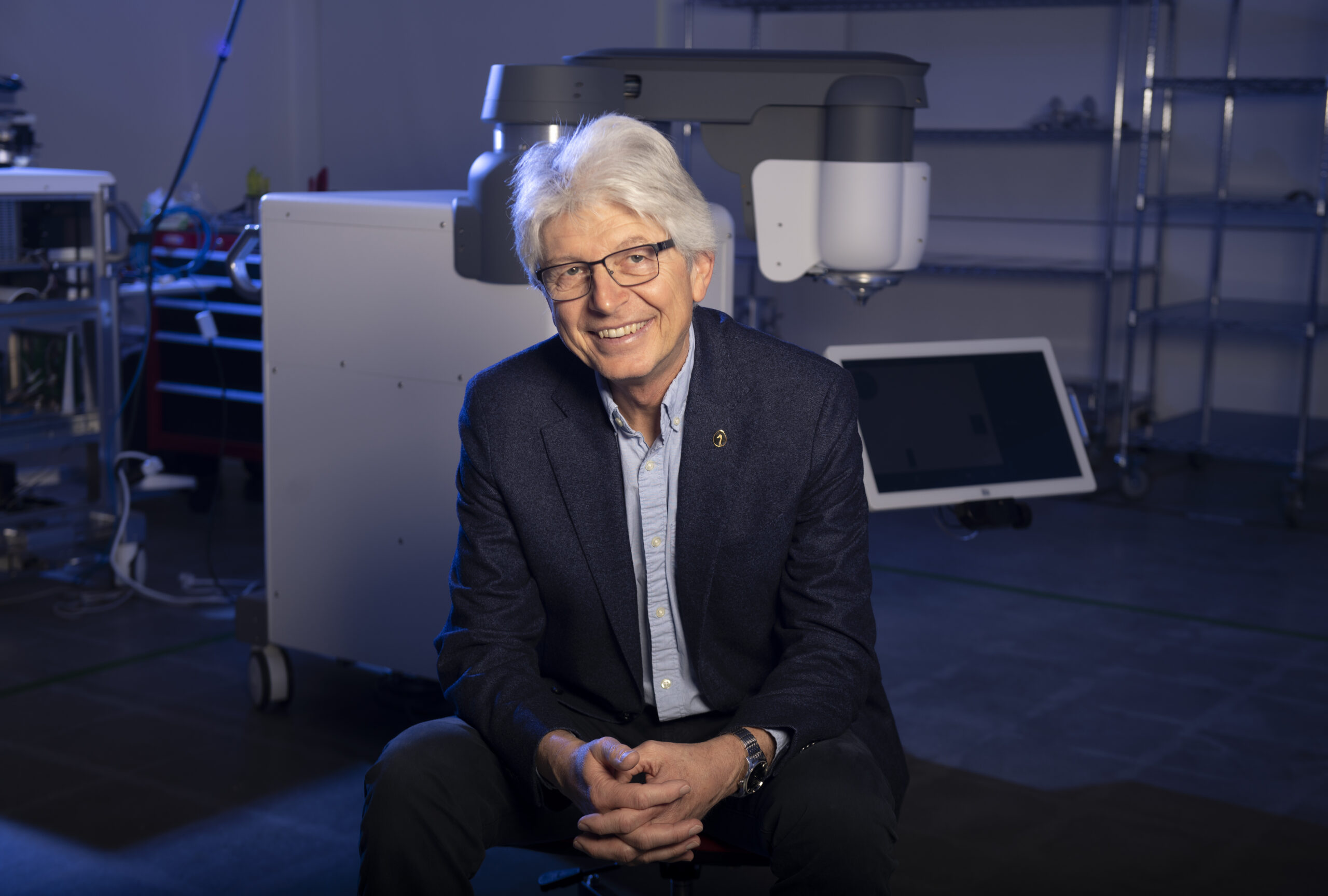Jill Kato, UC Irvine

Most people let go of a plan if it doesn’t pan out after a few months. Tibor Juhasz held onto his for more than two decades.
Back then, Juhasz, a physicist and biomedical engineer, was part of a team trying to develop a new kind of laser treatment for glaucoma.
It didn’t work.
But instead of dropping the aspiration, he put it on pause.
“We failed,” he says, laughing. “But the good thing is we failed early.”
It would be more than 25 years before that aspiration eventually developed enough to become ViaLase, his startup built around a femtosecond laser system that treats glaucoma with a procedure so precise, patients feel like nothing happened.
A femtosecond laser emits ultra-short pulses of light—each pulse lasts for just one hundred femtoseconds, or one hundred quadrillionths of a second (or 0.0000000000001 seconds). To put that in perspective, a femtosecond is to a second what a second is to about 32 million years. Because the pulses are so short and precise, they can cut or alter tissue at the micron level without damaging surrounding areas. It’s like doing surgery with a light beam so fine it doesn’t leave a mark.
This is the kind of precision Juhasz, a professor at UC Irvine with joint appointments in ophthalmology at School of Medicine and biomedical engineering at the Samueli School of Engineering, had in mind when he set out to change how millions of people manage a leading cause of blindness: glaucoma.
Glaucoma is the second leading cause of irreversible blindness in the world, affecting 76 million people globally—a number expected to rise to 112 million by 2040.
Glaucoma is known as the “silent thief of sight” for a reason—people don’t feel it. It damages the optic nerve over time as pressure builds up in the eye. By the time someone notices vision loss, it’s often too late to stop it.
The only proven way to treat glaucoma is by lowering intraocular pressure, usually through eye drops or invasive surgeries. But drops can be expensive, difficult to use consistently, and easy to forget—especially when you don’t feel that anything is wrong.
“The compliance rates with eye drops are terrible,” says Juhasz, who works out of the Gavin Herbert Eye Institute. “That’s just human nature. If you don’t feel pain, you don’t think it’s urgent.”
ViaLase offers an entirely new approach. Its FLigHT procedure, short for “femtosecond laser image-guided high-precision trabeculotomy,” uses tightly focused light pulses to create a microscopic channel in the eye’s drainage system, allowing fluid to flow and pressure to drop.
What’s revolutionary isn’t just what it does. It’s how it does it.
“This is a surgical procedure, but it’s not surgery,” Juhasz says. “There’s no incision, no implant, no cutting open of the eye. The laser goes through the cornea, and you don’t even feel it.”
From the patient’s point of view, the procedure couldn’t be simpler. A dome-like glass lens with gentle suction stabilizes the patient’s eye while a surgeon selects a treatment site using real-time imaging. Then the laser takes over. In minutes, the laser creates a drainage channel 500 microns wide and 200 microns high, or about the size of a grain of dust. That’s it.
There’s no pain. No recovery time. No visible wound. Patients walk out of the doctor’s office on their own, often seeing clearly right away. And so far, the treatment’s pressure-lowering effects have lasted for up to four years.
“We expect it will work even longer. And it can be repeated, since we’re only treating a very small portion of the drainage angle each time,” Juhasz says.
Juhasz’s technology may sound space-age, but it was born the old-fashioned way: through slow, stubborn perseverance.
When Juhasz first tried to apply femtosecond lasers to glaucoma, the technology wasn’t there. Imaging resolution was too low, and lasers weren’t precise enough. So, he changed direction.
Along the way, he developed the laser technology that would become IntraLase, the first femtosecond laser used in LASIK eye surgery. (In LASIK, the femtosecond laser cuts the cornea to reshape vision; in ViaLase’s procedure, it bores a microscopic tunnel inside the eye to relieve pressure.) That work earned him early recognition: in 2002, he was awarded the Berthold Leibinger Innovation Prize, a prestigious international honor for breakthroughs in laser technology.
Then in 2017, Juhasz realized the tools had improved enough that he could adapt them to treat glaucoma.
“The imaging was better. The laser was better. We could see what we needed to see and aim exactly where we needed to aim,” he says.
Juhasz began developing his work, thanks to funding from the National Institutes of Health. He later received a Proof of Product (PoP) grant from UC Irvine Beall Applied Innovation. PoP grants provide industry perspective and critical funding during a pivotal phase of development. For Juhasz, the PoP grant was instrumental in helping conduct early validation experiments using human cadaver eyes, which helped demonstrate viability outside of theory.

“The fact that the technology was coming from UCI gave it a lot of credibility with the investors,” Juhasz says.
Early on, Juhasz collaborated with UC Irvine professor Zhongping Chen from UC Irvine’s Samueli School of Engineering and Beckman Laser Institute to develop the first prototype used in the NIH-funded studies. ViaLase’s early results were promising. Patents were filed. Investors were approached.
ViaLase’s early traction was also helped by its location. Not just at UC Irvine, but in Orange County as well, which Juhasz calls “the center of the ophthalmic device industry.”
“This is where all the companies are, the experienced engineers, and investors who specialize in eye care,” he says. “In fact, when we started IntraLase, the investors made us move the company to Irvine because this is where the talent and ecosystem are.”
That proximity paid off—helping the company secure early investment, talent, and momentum. With that foundation in place, ViaLase began clinical trials, with first-in-human procedures taking place in Hungary in late 2020. The company announced in April 2024 that it had closed a Series C round, securing approximately $40 million in gross proceeds.
In recognition of his work as a translational innovator, Juhasz was named UC Irvine’s Entrepreneurial Leader of the Year in 2022. During that same year, he also received the Golden Goose Award from the American Association for the Advancement of Science, an honor given to researchers whose federally funded work has had unexpected, transformative societal impact.
ViaLase has now received CE mark approval, or a certification that their device meets health, safety, and environmental standards for sale in the European Union. They’re preparing for commercial launch in Europe this summer.
In the U.S., ViaLase is beginning a pivotal trial required for FDA approval—a randomized, two-arm study comparing ViaLase’s procedure to existing treatments, with a follow-up period of at least a year.
When asked what’s been the most rewarding throughout this long journey, Juhasz’s answer is immediate.
“It’s helping people. It’s improving lives. That’s the most exciting part,” he says. “Glaucoma may not kill you, but no one wants to go blind. If we can prevent that—if we can make it easy for people to keep their sight—that’s everything.”
And if there’s a message he wants to share with other researchers at UC Irvine or elsewhere, it’s this: don’t give up.
“This started in the mid-1990s. It’s 2025, and now we’re finally getting there,” he says. “It takes time. But if you believe in it, keep going.”

